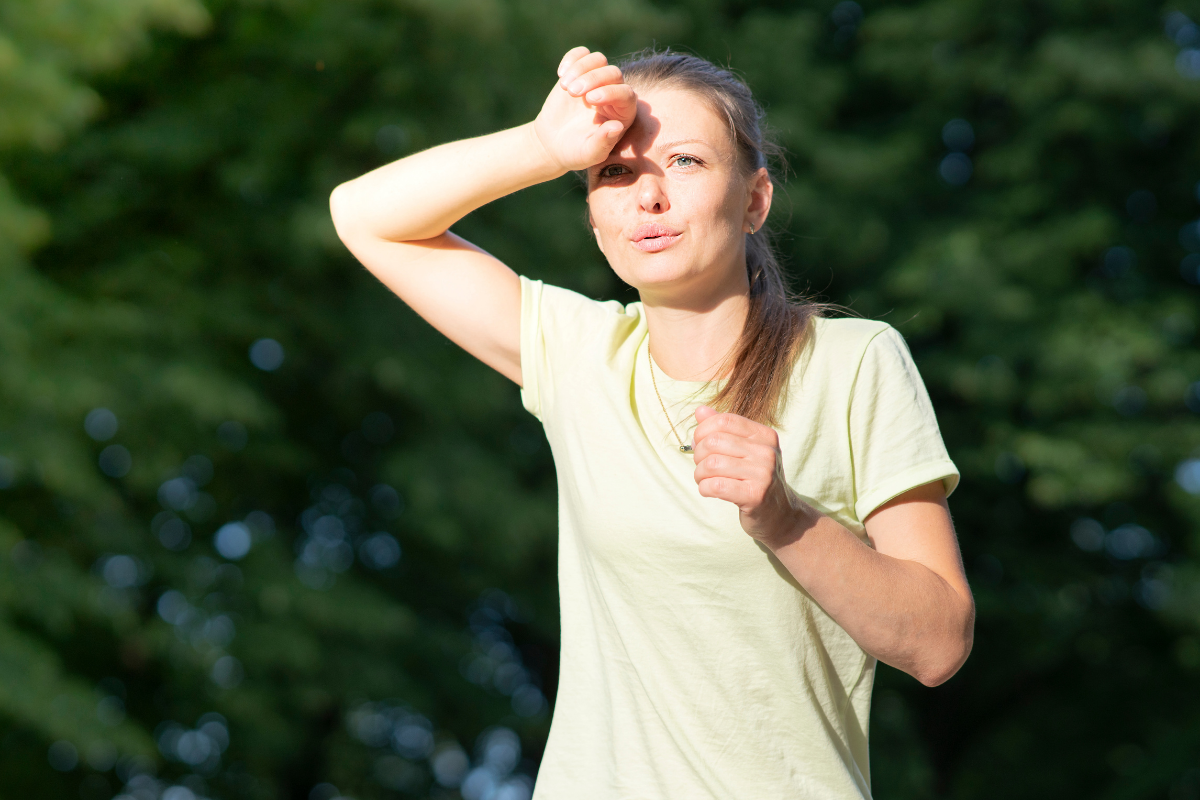Sunstroke, symptoms and treatment

Table of Contents
What is sunstroke?
You are enjoying the summer sun while playing your favorite outdoor sport. Suddenly you start having a little headache but you do not pay attention. The headache after a while turns into dizziness and you feel nauseous.
If you have ever experienced these symptoms, you have probably suffered from some form of heat stroke or sunstroke.
Sunstroke is the most common type of heat stroke. It is caused by prolonged exposure to the sun (thermal radiation), which, in many cases, can also lead to thermal exhaustion. Usually, there is an increase in body temperature, due to the inability to regulate it, resulting in overheating of the body.
How is the temperature of the human body regulated?
Normally, humans and mammals in general, have thermoregulatory mechanisms that are located in the brain and take care to maintain a constant internal temperature (for example in humans 36.8 ± 0.4 C). [1]
Initially, the human body’s heat receptors, or special nerve cells, detect changes in ambient temperature and “alert” the brain to a rise in temperature with messages sent to the general sensory center of the brain. [2]
The brain’s special temperature-regulating center then sends messages to the sweat glands and blood vessels on the surface of the skin, causing sweat to secrete and blood vessels to dilate, respectively. [2]
The combination of these two reactions helps maintain our body temperature in the following way: [2]
- The dilated vessels carry large amounts of blood to the surface of the skin, which, however, has cooled due to the evaporation of sweat.
- This causes the blood that reaches the blood vessels of the skin to cool and returning with the circulation inside our body to prevent its temperature from rising.
What factors cause it?
Sunstroke can occur from [3]:
- Exposure to hot environment.
- Intense activity at high temperature.
- Warm clothes that prevent sweat from evaporating and cooling the body.
- Alcohol consumption can affect your body’s ability to regulate your temperature.
- Dehydration due to increased sweating.
What are the symptoms of sunstroke?
The symptoms of sunburn are characteristic and vary depending on the degree of sunburn.
Mild form
- Feeling dizzy
- Symptoms of fatigue
- Redness of the skin
- Sweating problems
- Tinnitus
Moderate form
- Tithing and headache
- Motion sickness
- Vomiting
- Fast breathing
- Tendency to faint
- Muscle weakness or cramps
- Reduced sweating
- Burns or blisters on the skin
Heavy form
- Delusion and confusion
- Convulsions
- Hallucinations
- Dark urine (sign of dehydration)
- Pale skin
- High fever
How long can sunstroke last?
Depending on the severity of the sunburn, they can last up to 2 days. However, the body is likely to recover from sunburn from 2 months to 1 year [1].
If the symptoms of sunburn do not improve within an hour, it is advisable to seek medical help.
What is heatstroke?
Heat stroke is characterized by overheating of the body (hyperthermia) and is a severe and clinically urgent condition.
What forms of heatstroke are there?
Heat stroke belongs to the category of thermal injuries during the Advanced trauma Life Support (ATLS). It is divided into 2 clinical forms, the classic heat stroke and the heat stroke due to exercise. [2]
- Classic heat stroke: the main cause is exposure to extremely high temperatures and usually affects people who do not have the proper thermoregulatory mechanisms (for example the elderly, people with cardiovascular problems).
- Heatstroke because of exercise: usually affects young people and people who play sports outdoors under extremely high ambient temperatures and high humidity regime.
What are the symptoms of heat stroke? [3] [5]
- High body temperature: Elevated body temperature is the main feature of heat stroke.
- Mental disorders: These may include confusion, seizures (especially in children), delirium, irritability and coma.
- Changes in sweating: In a state of heatstroke the skin turns hot and dry (absence of sweating-late symptom)
- Nausea: Feeling unwell or needing to vomit.
- Headache: A throbbing headache that is found mainly on the forehead or on the entire skull.
- Discoloration of the skin: The skin turns red as the body becomes warmer.
- Breathing: Breathing can become faster and shallower.
- Heart rate: As the body tries to cool down, the heart comes under increasing pressure causing the heart rate to rise.
Risky groups
Although everyone is at high risk for sunburn, after prolonged exposure, there are some population groups that are more vulnerable. These are:
- Elderly people
- Children and babies
- People with cardiovascular problems
- People with kidney failure
- People with diabetes
- Those who face special pathological conditions
Sunstroke and children
Exposing children to the sun for a long time may cause sunburn. The reason this phenomenon is more pronounced at a young age is because the bones on the head, as well as the skin are thinner, resulting in hyperthermia if not properly protected. [8]
Sunstroke treatment
In case you suspect or show any symptoms that refer you to sunburn, then: [3]
- Move away from direct sunlight and approach a cool and shady place. Ideally choose a place with air conditioning.
- Lie down and lift your feet slightly.
- Cool the body immediately, using any means at your disposal. For example, you can make compresses with a cool towel or use a water spray. Cold compresses on the armpits, neck and generally on the body are also very beneficial. At the same time, monitor your body temperature and keep trying to cool down until your body temperature drops.
- Hydrate your body with plenty of water. Sports drinks or electrolytes are a good help.
- Get medical help as soon as possible.
Nutrition
To prevent this unpleasant and at the same time dangerous condition, it is recommended to avoid the consumption of caffeine and alcoholic beverages, as they have a diuretic effect and have the ability to further dehydrate the body.
In addition, it is recommended to consume fruits and vegetables, as they have a high water content and enhance the hydration of the body.
More specifically, cucumber, tomato, celery, green leafy vegetables, broccoli, carrots, strawberries, watermelon, melon, oranges and pineapple are foods with a water content of over 90%.
Prevention
In any case, the best treatment is prevention. Some important guidelines [4]:
- Try not to be exposed to the sun for many hours.
- Avoid the sun between 11am and 3pm.
- Use sunscreen with SPF30 or higher.
- Take care of your clothes, choose light colored clothes.
- Hydrate your body regularly. Consumption of caffeine and alcoholic beverages do not help hydrate the body.
- You can take electrolytes, which produce energy and contribute to better hydration of the body.
- It is equally important to follow a moisturizing diet, which will include a lot of fruits and vegetables, for example, prefer watermelon, melon and cucumbers.
- Exercising outdoors at a high temperature is best avoided.
Other ways to avoid a heat stroke:
- Check the color of your urine. Darker urine is a sign of dehydration. Make sure you drink plenty of fluids to keep your urine very light in color.
- Measure your weight before and after physical activity. Monitoring the weight lost water can help you determine how much fluid to drink.
Electrolytes: why are they important [8]
During the hot summer hours and especially when exercising at particularly high temperatures, you should not fail to consume an electrolyte solution.
Prolonged sweating will cause you to excrete large amounts of electrolytes. For this reason, symptoms such as weakness, muscle spasms (cramps), heart arrhythmia, changes in blood pressure, confusion, numbness, nervous disorders, and even seizures may occur.
As you can see, many of the symptoms of heatstroke and sunstroke are synonymous with electrolyte deficiency. For this reason it is of utmost importance to carry out even their preventive consumption. Remember that electrolytes contribute to:
- the communication of nerve and muscle cells
- the contraction of muscles
- the transport of fluids in the body (intracellular and extracellular)
- maintaining blood acidity
At Vita4you.gr you will find a wide variety of sunscreens for skin protection from the sun’s rays and also electrolytes for hydration!
Sources
Disclaimer
The content of this blogspot is not and can not be considered as medical advice, diagnosis or treatment. All information is provided to readers solely for informational purposes. There is no intention to substitute this content for personalized medical advice, diagnosis, prognosis or treatment.



Leave a comment